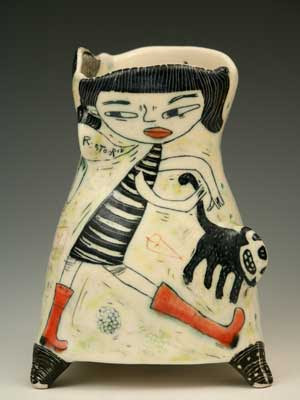Maybe it’s because I was too busy writing notes or maybe it was because my camera battery died early in the demo, but I didn’t get too many photo’s of the Julia Galloway workshop that I attended last weekend with friends Linda Fahey, Hue Yang, Tiffany Schmierer, and Margaret Tassi. That being said, it was the best workshop ever!
I was completely blown out of the water by the artist. Galloway was hilarious, generous, commanding, eloquent, down-to-earth, talented, intelligent, informed, and brutally honest. I kept leaning over to Linda and Tiff to gush the overflowing awe I was experiencing in her midst. He he he... I think we were all equally inspired, because we all had huge smiles on our faces every time I checked.
In an incredible six hours, Galloway covered throwing techniques, altered thrown forms, slab construction, unique handle pulling, pillow forms, spout building, glaze formulation, mishima, shellac resist, wax resist inlay, combined surface design techniques, surface design principles, color theory, creative philosophy, copyright issues, contemporary ceramics, history of ceramics, teaching philosophies, and of course a retrospective of her own work. And even after all that, she rushed over to Trax Gallery, to give an artist talk at the opening of her fantastic solo show.
Though I did glean plenty of technical tips from this workshop, the real gems of the experience were in the little moments of creative wisdom that Galloway shared with us. These moments were so fleeting and so plentiful that if you weren't paying very close attention (perhaps, even at the cost of great photographs) you would miss them. I highly recommend attending any workshop, demonstration, or lecture from the artist as her honest insight is unparalleled in the ceramic arts community. I hope that in the future I will have the chance to take an intensive workshop with her. I think there is so much more to learn from her and I am jealous of all the students at University of Montana in Missoula who have access to her wisdom all the time.
On that note, I'll leave you with one little bit of wisdom that made me laugh over and over again as she said it. If all else fails, and "you get caught naked... just strut what you've got."
For more (and much better) photos and a couple more workshop reviews, check out
Linda's post. Also, a big thank you to the folks who organized the workshop over at
Walnut Creek Civic Arts Center. I had a lovely time and the potluck was delish!






















